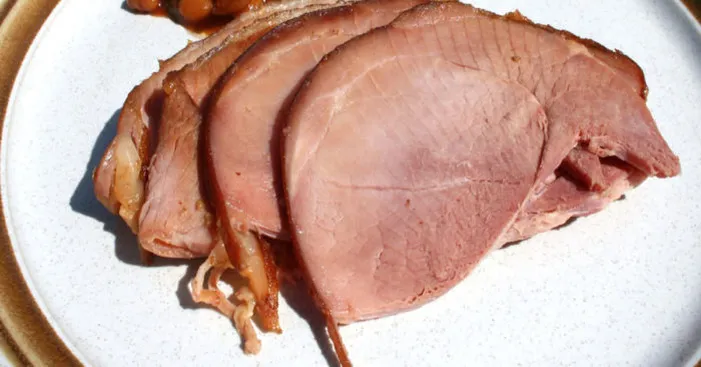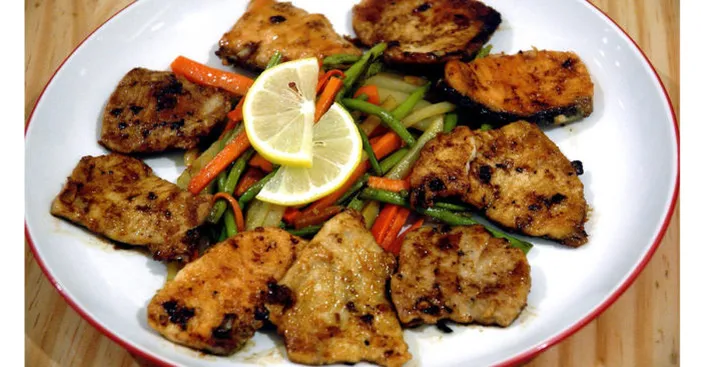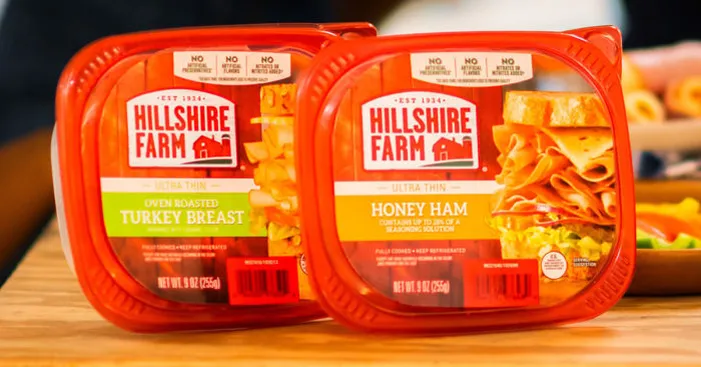Table of Contents

Turkey slice calories is a general term as we generally use the word calories to refer to the nutritional values and also the slices can come from different parts of turkey meat.
Turkey slices are among the favorite type of food in the US and Canada as it is very popular in sandwiches.
This type of meat is among the processed meats alongside hot dogs, salami, and hamburgers.
These yummy turkey slices are made of turkey breasts baked or smoked then sliced.
However, different types of turkey slices vary from healthy to unhealthy.
For instance, most common thin turkey slices are processed with nitrate and preservatives and they are unhealthy.
On the other hand, turkey slices made from natural cooked breasts with no filler ingredients are more natural and healthy.
Regardless of the way, it’s been processed, turkey breasts are then cut to obtain slices round or square-shaped.
The most common turkey slices we use in sandwiches are sadly the ones that are treated with nitrate and preservatives.
Nonetheless, turkey slices made without fillers are among the best choices for those who want to eat meat in a low fat or calories diet.
Turkey slice calories:
Turkey slice calories (with filler ingredients):

Often referred to as turkey ham, these slices of turkey are made from thighs, water, and other additives.
These additives are mostly used to add a smoking flavor or preserve the slices for a longer time.
The main processing technique to make turkey ham is curing which can be done in many ways.
It is a preservation method that involves the addition of salt, nitrate, or sugar and also smoking or cooking if needed.
Due to the addition of salt, the meat often loses its water content and that makes it uninhabitable by microbes.
As a result, these turkey ham slices have a longer lifespan and are ready to eat.
By extending its preservation, turkey ham slices offer a profitable product that explains its popularity.
Proteins:
Turkey slice calories offer a considerable amount of proteins with up to 16.5g per serving (3 slices, 85g).
Nutritionists recommend consuming two to three portions of protein daily to reach the needs.
This is because our bodies need a constant supply of proteins to be able to have a balanced metabolism.
For 130lbs bodyweight, a serving of 3 turkey ham slices offers about 35% of the daily need in protein.
Calories and fat:
Turkey ham slices tend to have more calories than their counterpart slices made from naturally cooked turkey breast.
In fact, a serving of 3 thin turkey ham slices contains about 105 calories 28 of which come from fats.
The fats in these processed slices are about 4.1g and are mainly unsaturated fats (66%).
Doing simple math we get about 2.7g of unsaturated fats from these slices in the form of monounsaturated and polyunsaturated fats.
Vitamins and minerals:
To sum up, 3oz (85g) of turkey ham slices calories contain:
- Calories: 105
- Protein: 16.5g
- Fats: 4.1g
- Sodium: 827 mg (35% RDI)
- Cholesterol: 56mg (18% RDI)
- B6 vitamin: 10%
- B12 vitamin: 14%
- Calcium:
- Potassium: 5%
- Iron : 6%
- Zinc : 12%
- Selenium: 20%
- Magnesium : 3%
Turkey slice calories (without filler ingredients):

Proteins:
In this sense, consuming a serving of turkey slice would definitely help you reach the daily needs in proteins (0.36g per 1lbs of body weight).
These turkey slice calories are richer in proteins than the slices made from the thighs as they offer 18.4g per serving (3oz, 85g).
A serving of breast turkey slices would offer up to 40% of the daily need for protein for someone who weighs 130lbs.
Calories and fats:
One serving of turkey breast slices (3 slices, 78g) is only 90 calories which is suitable for a low-calorie diet.
However, to consider these turkey slice calories in a balanced diet you must combine them with seeds and vegetables.
As for the fat content, breast turkey slice calories are very low in fat content with only 0.9g of fats per serving.
Vitamins and minerals:
To sum up, 3oz (85g) of turkey breast slices calories contain:
- Calories: 90
- Protein: 18.4g
- Fats: 0.9g
- Sodium: 591 mg (25% RDI)
- Cholesterol: 45mg (13% RDI)
- C vitamin: 8.5%
- B1 vitamin: 7%
- B2 vitamin: 15%
- B3 vitamin: 30%
- B6 vitamin: 18%
- Calcium: 1%
- Potassium: 4%
- Iron : 3%
- Zinc : 12%
- Phosphorus : 12%
- Selenium: 22%
- Magnesium : 3%
Benefits of turkey slice calories:

There are nutritional differences between turkey slices made from ham and the ones made from breasts.
Nonetheless, the micro-nutrients in these two types of turkey slices are the same they just differ in portions.
In that sense, those little elements that can be found in turkey ham or breast slices have many benefits such as:
Good source of phosphorus:
As the second most abundant nutrient, phosphorus plays an important role in maintaining teeth and bones healthy.
Also, this mineral is essential for DNA and RNA formation, brain development, energy formation, and overall growth.
Consuming turkey slices offer a good boost (12%) to help us reach the daily recommended intake of phosphorus.
Offers Iron:
Even though, turkey slices offer a little amount of Iron (6%) it is still quite helpful to reach the daily needs.
Especially with Iron, the body should never lack its daily dose as an Iron deficiency can lead to serious problems.
In fact, Iron is an essential element that plays a key role in oxygen transport and mostly in the formation of red blood cells.
In addition, the body uses Iron to create several enzymes, hormones, and neurotransmitters.
Contains selenium:
As one of the most abundant minerals in turkey slices, selenium has great antioxidant properties to offer.
In fact, a serving of turkey slices (3oz, 85g) offers somewhere between 20 and 22% of the daily need in selenium.
This is very beneficial as the body can use selenium to reduce the risk of cardiovascular diseases.
Also, selenium can prevent mental decline and keep the thyroid gland functioning in a balanced manner.
Great source of zinc:
Eating 2 to 3 slices of turkey help the body meet its needs in zinc as that amount offer about 12% of the daily need.
This may seem like a small amount, but we do get zinc from the other food we eat and a little boost can help.
Several studies confirm the efficiency of zinc in boosting sexual health for both men and women.
Zinc also plays a role in the production of genetic material, wound healing, and skin health.
Benefits of turkey slices for certain group of people:
Thanks to its richness in protein, vitamins, and minerals, turkey slice calories can have great benefits for :
- Pregnant women: B vitamins in turkey slices are a great asset to provide essential nutrition for the mother and the fetus.
- Hard labor workers: This group of people experience muscle pain and fatigue therefore, need more protein to recover their muscles.
- People with insomnia or depression: Turkey slices offer tryptophan that our bodies use to create serotonin AKA “the hormone of happiness”.
- Nursing mothers and children: Turkey slice calories are easily digested and can be among the essential nutrients for young people and nursing moms.
Consuming turkey slices:
Fried turkey slices:

Ingredients:
- Turkey slices.
- 2 cups of milk.
- 1 egg.
- Salt.
- White flour.
- ½ cup of corn oil.
- 1 tbsp of mustard.
Preparation:
- Start by washing the turkey slices in a bowl full of water and a bit of lemon juice.
- In another bowl, mix the milk with the egg, salt, and mustard.
- Cover the mustard mixture and let it rest in the fridge for 2 hours to use later as a dipping sauce.
- Heat the corn oil in a frying pan at a low-temperature 160°F (70°C).
- Scatter some of the flour on the kitchen table or a tray then use it to cover each turkey slice with flour from both sides.
- Now the oil should be hot enough for frying, go ahead and fry the turkey slices for 15 minutes until they turn golden.
- You can then serve the fried turkey slices on a plate with the dipping mustard sauce on the side and other ingredients of your choice (lemon slices, cherry tomatoes…).
Turkey slices with sautéed vegetables:

Ingredients:
- 1 lb of turkey slices (6 to 8 slices).
- 4 tbsp of olive oil.
- 1 cup of flour.
- 2 tbsp of butter.
- ¼ cup of milk.
- 2 tbsp of lemon juice or 1 juiced lemon.
- 1tsp of salt and ground pepper.
- 2 cups of chicken broth.
- 1 zucchini, 2 carrots, 2 peppers (sliced).
- ¼ cup of green beans.
- Chopped parsley for decoration.
Preparations:
- Place the turkey slices on a tray then season them with salt and ground pepper.
- Dip the seasoned turkey slices in milk then scatter flour on them.
- Heat olive oil in a pan then start frying the turkey slices for 15 minutes at a low temperature of 160°F (70°C) until they turn brown.
- Take out the fried crispy turkey slices and let them cool on the side.
- Add butter, 2 tbsp of flour, lemon juice, and chicken broth to the frying pan and stir.
- Now add the fried turkey slices to the white sauce and turn the heat down to 120°F (50°C).
- Let the white sauce cook until it starts boiling, meanwhile start heating olive oil in a new pan.
- Start frying the sliced zucchini, carrots, peppers, and green beans.
- It should take about 5 minutes to sautée all the vegetables on medium heat of 300°F (150°C).
- Check the turkey slices in the white sauce and see if they are well-cooked, if so take them off the heat.
- Put the turkey slices on the dishes, pour the white sauce on it then place the sautéed vegetables on the side ad decorate with chopped parsley.
PS: you can also add boiled rice to the recipe.
Precautions you need to know about turkey slice calories:

Just one slice of turkey ham usually contains more than 300mg of sodium and that is about 20% of the daily need.
Taking into consideration the fact that we do get sodium from other food, eating turkey slices may cause an overdose.
High sodium levels may cause many cardiovascular issues as they have a direct impact on blood pressure.
Certain types of turkey slices may be over-processed and some even contain more additives and fillers than the actual meat.
These processed turkey slices are among the least favorable processed meat as they may cause many side effects such as:
- Chronic diseases.
- High blood pressure.
- Stomach cancer.
- Cross-contamination.
Buying turkey slices:

There are a lot of bad products in the market and unfortunately, the most common ones are not that healthy.
In fact, many people don’t even know that some products contain more water and additives than turkey meat.
However, you can still find healthy turkey slice brands that are recommended by nutritionists.
Whether you are buying breast turkey slices or turkey ham slices, always look for products with more than 50% turkey.
Storing turkey slices:

The storing period of turkey slices depends on many conditions…
If the packaging of any type of turkey slices is open, the clock starts ticking and the lifespan is reduced to hours.
Specialists claim that once we take turkey slices out of the refrigerator and open the package, it only takes 2 hours for the bacteria to grow.
Because of that, make sure you only open your turkey slice package at the very last moment and use it quickly.
As for the rest of the slices, refrigerate them in an airtight container as fast as possible with minimum exposure to air for no longer than 3 days.
In case the package is still intact, you can keep it for 5 days In the fridge and up to 12 months in the freezer.
However, once you thaw frozen turkey slices in the microwave or water, you must consume them immediately.
The best practice is to store packaged turkey slices in the freezer then thaw them in the refrigerator 1 day before consumption.
